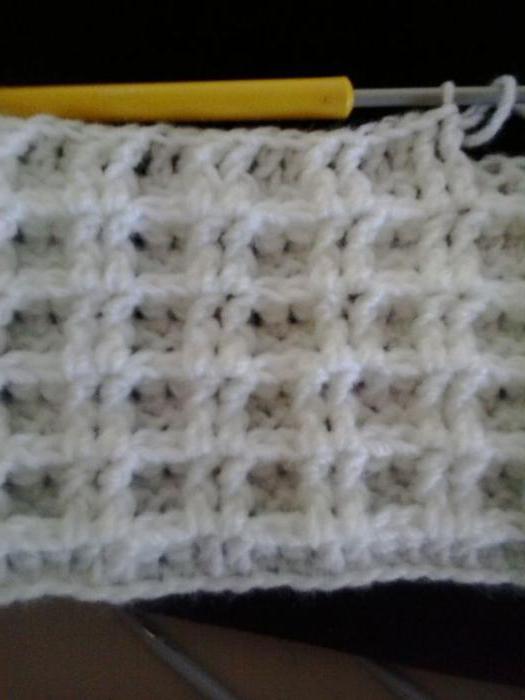Dense crochet patterns without holes. Dense and continuous crochet patterns.
25.08.2014
- the absolute opposite of openwork patterns.
Dense patterns knitted with half columns, or connecting columns. They are a little reminiscent of fabric knitted on knitting needles: the reverse side of the colored knitting looks the same, and the edge knitted with half-stitches on the front half-loop is twisted in the same way. Such patterns are suitable for knitting socks, gloves, winter hats, work sweaters, etc.
Solid patterns formed by alternation and weaving various types double crochets.
When crocheting, we don’t always want to make the item openwork. Sometimes it is necessary for part of the product to be denser, for example the yoke, bodice area, top part skirts. For such cases, in this collection you can choose patterns with greater visual density, despite the fact that it is crochet. The fact that all patterns not made with knitting needles are completely transparent is a misconception. And you can crochet a pattern that completely covers what we don’t want to show. And, by the way, this is not only a canvas made of single crochets! Admire - the patterns here are quite dense, without much “holeiness”. But this concept is relative and subjective, so it’s better to look at openwork patterns, meshes, and other original patterns.
We offer you a collection dense and continuous patterns
for crocheting with patterns, descriptions and symbols. The diagram clearly demonstrates the design of the pattern and allows you to easily track the order of knitting loops and rows. This is especially important when making complex multi-level patterns.
Choose and create with pleasure!
Abbreviations:
n. - loop(s);
air p. - air loop;
Art. - column;
cross. - crossed;
conn. Art. - connecting post;
semi-st. - half-column;
semi-st. s/n - half double crochet;
Art. b/n - single crochet;
Art. s/n - double crochet;
Art. s/2n - double crochet;
Art. s/3n - double crochet stitch.
persons - facial;
purl - purl;
length - elongated.
Pattern 11 "Long double crochet"
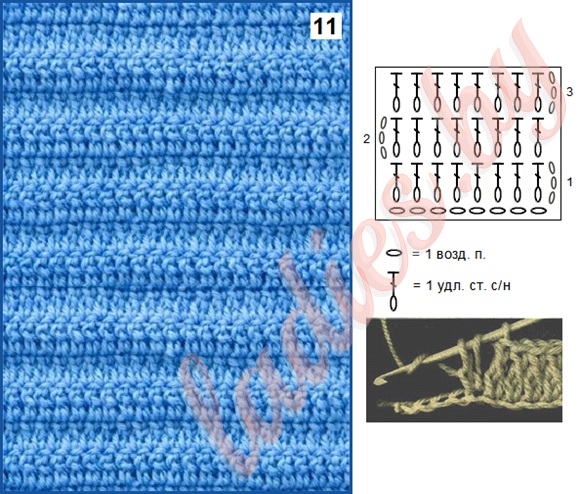
This simple all-over pattern is made from long double crochets that are worked into the stitch of the previous row. This technique“lengthening” is obtained by knitting air. loops before starting to knit the yarn over.
Start with a chain of chain stitches. Knit the first stitch in the 4th row from the hook. loop. Yarn over, insert the hook into the loop, grab the working thread and pull it through the loop. There are 3 loops on the hook. Then knit air. loop through the first loop on the hook. Then knit a loop and yarn over. Finish the stitch by knitting the remaining 2 loops.
1 row: 3 air. lifting item; 1 length st.s/n in each air. P.
2nd row: 3 air. lifting item; 1 length st.s/n in each extension. Art. s/n of the previous row.
Pattern 10 "Double crochet"
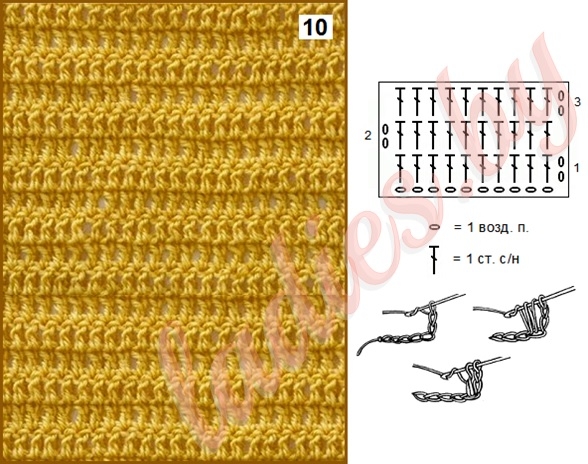
This simple all over pattern is made from double crochets that are worked into the double crochet of the previous row. As always, start with a chain of chain stitches, knit the first stitch in the 3rd chain from the hook. loop.
1 row: 2 air lifting item; 1 tbsp s/n in each air. P.
2nd row: 2 air lifting item; 1 tbsp s/n in each st. s/n of the previous row.
Knit all other rows as the 2nd row.
Pattern 9 "Two-color single crochets"
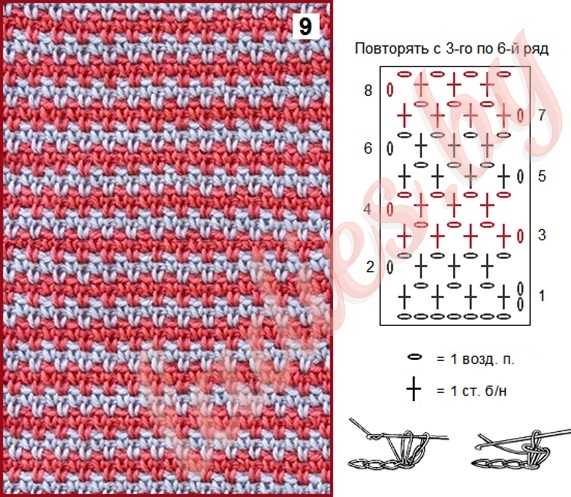
This beautiful dense pattern is formed by alternating single crochets and chain stitches. The columns are knitted “into the arch” of the air loop of the previous row. Color changes occur at the beginning of odd rows.
1 row (gray): 2 air lifting item; * 1 tbsp. b/n; 1 air n. skip; 1 air P.**; repeat from * to **; 1 tbsp. b/n.
2nd row (gray)
Row 3 (red)
4 row (red): 1 air lifting item; 1 air P.; * 1 tbsp. b/n in the air arch. loops of the previous row; 1 air P.**; repeat from * to **.
5 row (gray): 1 air lifting item; * 1 tbsp. b/n in the air arch. loops of the previous row; 1 air P.**; repeat from * to **; 1 tbsp. b/n in the air arch. loops of the previous row.
Row 6 (gray): 1 air lifting item; 1 air P.; * 1 tbsp. b/n in the air arch. loops of the previous row; 1 air P.**; repeat from * to **.
Repeat from the 3rd to the 6th row.
Pattern 8 "Single crochet"
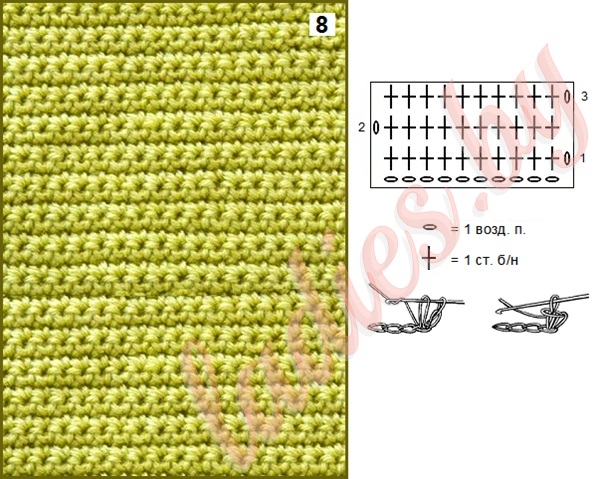
This simple, tight single crochet pattern holds its shape well. As always, start with a chain of air. loops, knit the first single crochet into the 2nd loop from the hook.
1
row: 1 air. lifting item; 1 st.b/n in each air. P.
2nd row: 1 air lifting item; 1 tbsp in each st. b/n of the previous row.
Knit all other rows as the 2nd row.
Pattern 7 "Half double crochet"
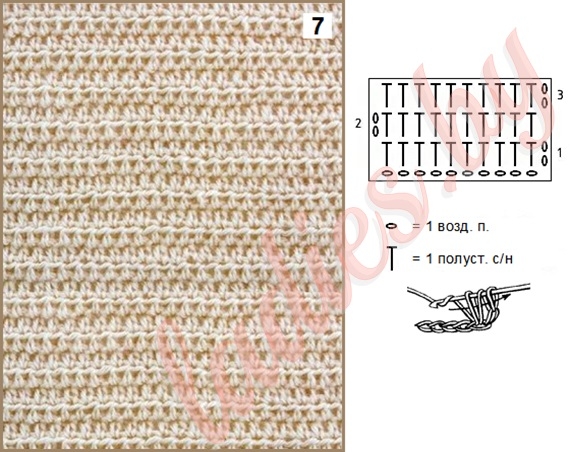
Pattern 6 "Bosnian knitting"
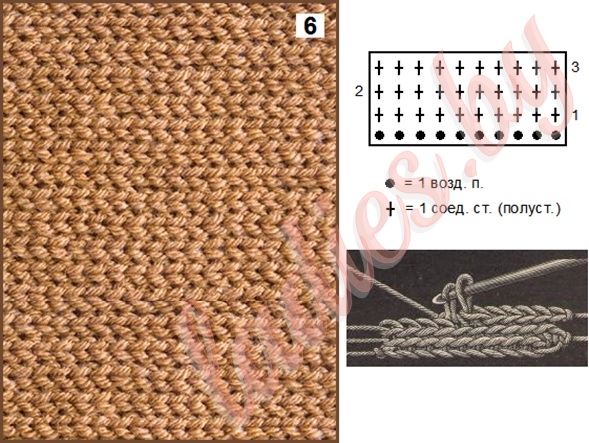
The Bosnian pattern is knitted in half stitches behind the back wall of the loop. There is no need to knit a lifting loop, but always knit the first stitch in the row behind both walls of the loop in the 1st loop from the hook. This pattern is very dense, almost does not stretch in width, but stretches quite well in length.
Pattern 5 "Relief rows"
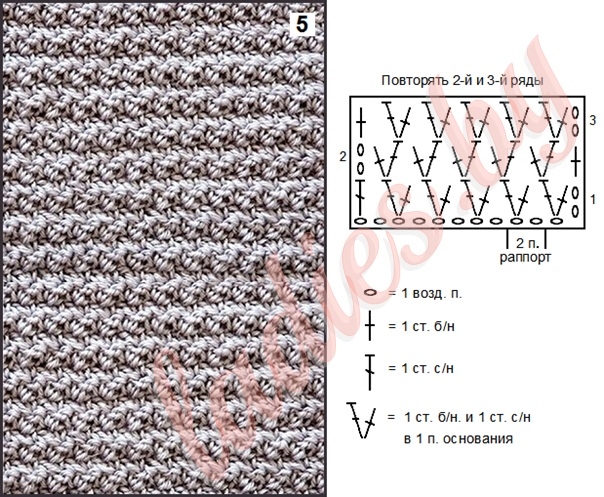
Air number p. set in multiples of 2 + 1 air. p. for symmetry of the pattern + 2 air. lifting point.
1 row: 2 air lifting item; * 1 tbsp. b/n and 1 tbsp. s/n in the next air. P.; 1 air n. skip**; repeat from * to **; 1 tbsp. s/n in the last air. P.
2nd row
3rd row: 2 air lifting item; * 1 tbsp. b/n and 1 tbsp. s/n in art. s/n of the previous row**; repeat from * to **; 1 tbsp. b/n in air p. lifting the previous row.
Repeat rows 2 and 3.
Pattern 4 "Hedge-2"
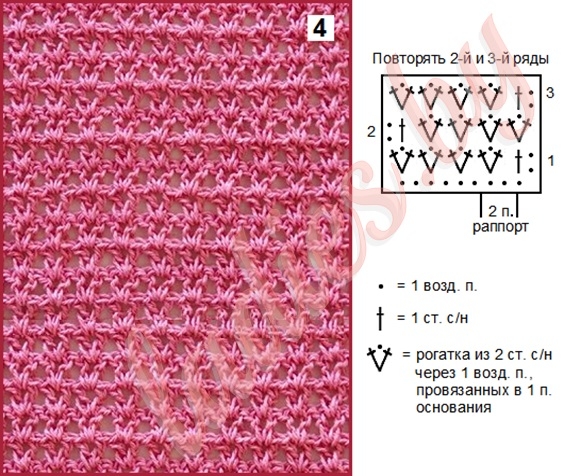
Air number p. set in multiples of 2 + 1 air. p. for symmetry of the pattern + 2 air. lifting point.
1 row: 2 air lifting item; 1 tbsp. s/n; * 1 air n. skip; 1 tbsp. s/n, 1 air. p. and 1 tbsp. s/n knit in the next air. P.**; repeat from * to **.
2nd row
3rd row: 2 air lifting item; 1 tbsp. s/n; * 1 tbsp. s/n, 1 air. p. and 1 tbsp. s/n knit in an arch between two sts. s/n of the previous row**; repeat from * to **.
Repeat rows 2 and 3.
Pattern 3 "Hedge-1"
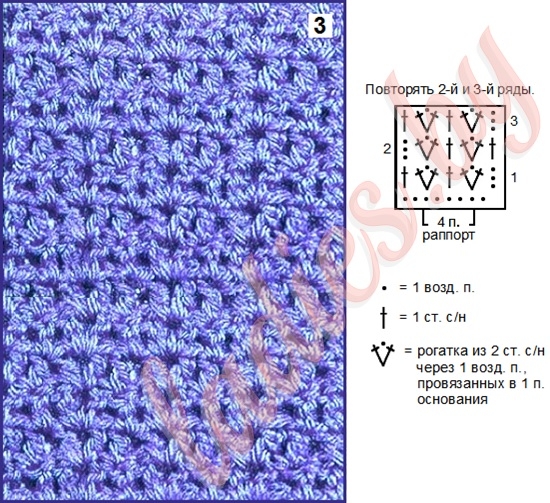
Air number set in multiples of 4 + 3 air. lifting point.
Pattern 2 "Sea Buckthorn"
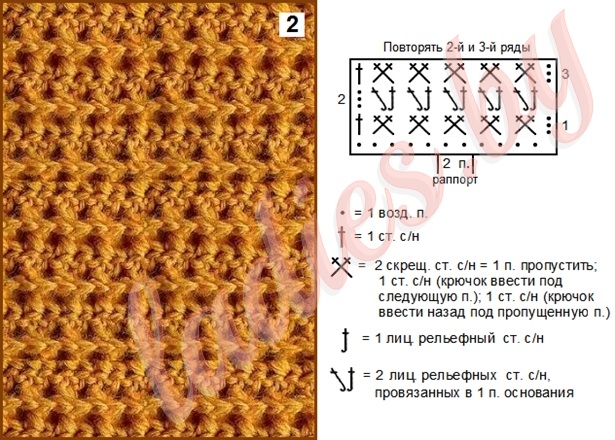
Air number p. set in multiples of 2 + 1 + 3 air. lifting point.
Pattern 1 "Relief of lush columns"
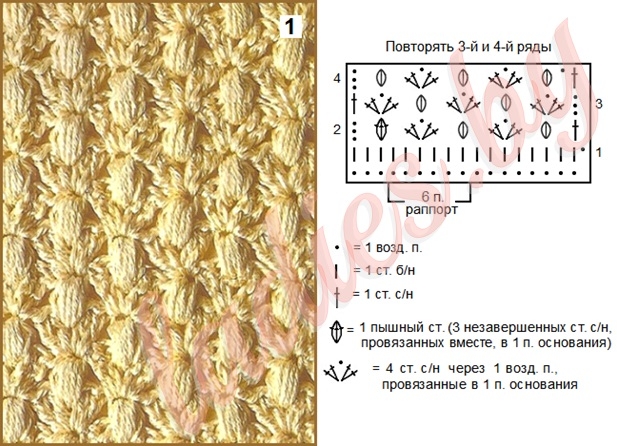
Air number p. set in multiples of 6 + 5 + 1 air. lifting point.
1 row: 1 air lifting item; 1 tbsp. b/n in each air. P.
2nd row: 3 air. lifting item; 2 tbsp. b/n skip; 1 fluffy tbsp. (3 unfinished sts. s/n, knitted together, in 1 p. base) in the next st. b/n; * 2 tbsp. b/n skip; 2 tbsp. s/n, 1 air. p. and 2 tbsp. s/n in the next st. b/n; 2 tbsp. b/n skip; 1 fluffy tbsp. in the next Art. b/n**; repeat from * to **; 1 tbsp. b/n skip; 1 tbsp. s/n in the last st. b/n.
3rd row: 3 air. lifting item; * 2 tbsp. s/n, 1 air. p. and 2 tbsp. s/n in lush style; 1 fluffy tbsp. in air n. groups art. s/n of the previous row**; repeat from * to **; 2 tbsp. s/n, 1 air. p. and 2 tbsp. s/n in the last magnificent st.; 1 tbsp. s/n in air. p. lifting the previous row.
4 row: 3 air. lifting item; 1 fluffy tbsp. in air P. last group Art. s/n of the previous row; * 2 tbsp. s/n, 1 air. p. and 2 tbsp. s/n in lush style; 1 fluffy tbsp. in air p. between next group Art. s/n**; repeat from * to **; 1 air P.; 1 tbsp. s/n in air. p. lifting the previous row.
Repeat rows 3 and 4.
Crochet patterns of dense patterns are considered the best solution for knitting warm winter products and household items. Jackets, blankets, sweaters and ponchos are not only thick enough, but also attractive. Such things self made They will keep their shape perfectly and practically not stretch.
Dense crochet patterns: diagrams and descriptions
A distinctive feature of dense patterns from other crocheting methods is that the main elements in the work are the columns, and the air loops only open and close the row. Dense patterns have many variations. A special texture and density can be added to the knitting using the following techniques:
- knit loops behind the front or back wall;
- vary the height of the columns;
- use crossed columns;
- knit lush columns without fastening;
- use various variations embossed double crochets;
- pull the loops up or down.
In addition, originality and beauty knitted product can be added if several threads of different colors are used simultaneously in the work. A dense pattern can be made double-sided, which is perfect for products that do not have a reverse side. For example, you can knit a scarf, hat, poncho, cape, or blanket with this pattern.
The peculiarity of knitting this pattern is that each row is alternated by knitting columns behind the front or back wall. The result is a rather cute pattern of symmetrical convex sticks. This pattern will be an excellent decor. winter sweater or sleeveless vests. In addition, you can always diversify it by making columns with a slight slope to the right or left, lengthening the lines or intertwining them with each other.
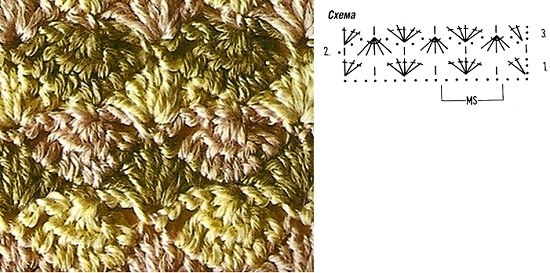
A multi-color pattern in the shape of shells is perfect for creating a beautiful neckline on a woman's blouse, and will make a sweater light and airy. Despite the fact that the pattern is knitted in fairly tight double crochets, ready product It turns out with an airy openwork pattern. In your work, try using 2 or 3 colors at the same time, as well as interlacing threads different shades. This will make the finished product look much more attractive.
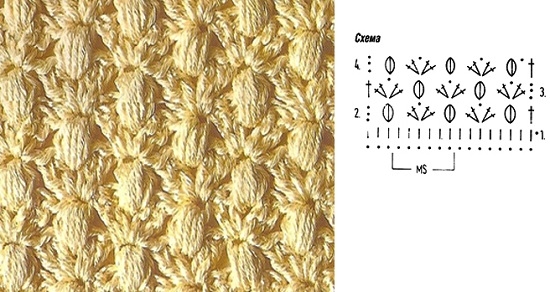
The dense “Pineapples” pattern looks very cute and neat. Thanks to the monotony and regular repetition of patterns, knitting such a pattern is a pleasure. You can easily decorate a children's scarf or hat with a fruit theme, as well as knit a soft and comfortable blanket that will keep you warm for a long time. winter evenings. In addition, if you use pineapples as a pattern for a sweater, you can decorate them symmetrically with beads or sequins - it will turn out very beautiful and unusual.
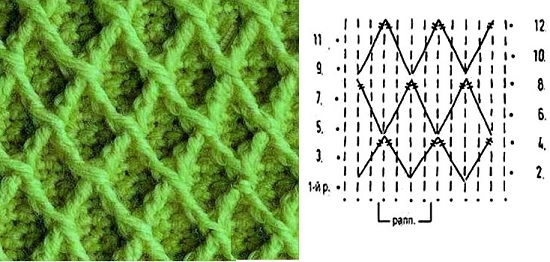
The dense pattern “Convex grid” is based on ordinary single crochets, which are subsequently decorated with deep double crochets crossed with each other. This pattern is most often used when knitting men's sweaters, sleeveless vests and vests. The pattern will also look very beautiful on knitted fabrics. women's bags, leggings and mittens.
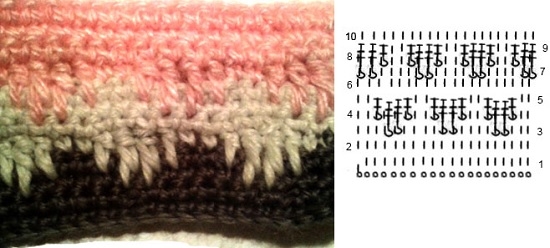
As a finish various products you can use a dense crochet pattern “Graceful Waves”. It will decorate the bottom knitted dress or skirt, will be a wonderful pattern for decorating the sleeve or neck of a sweater. True, to create it you will have to work a little, twisting various double crochets according to the diagram.
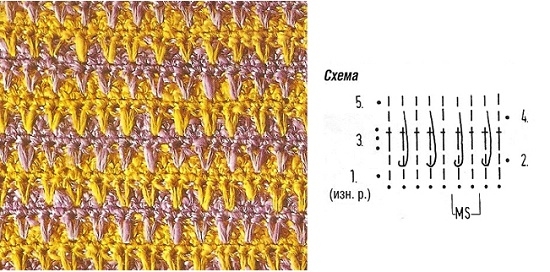
If you have knitting skills jacquard patterns knitting needles, then making a similar pattern using a crochet pattern will not be difficult. Knitting is based on ordinary single crochets, which in the 3rd and 4th rows harmoniously intersect with double crochets.
The peculiarity of this pattern is that a convex pattern of two crossed threads is formed on the surface of the product. This dense pattern will perfectly complement any knitting. But it is not recommended to re-thread when knitting children's clothes, since the baby's fingers can get stuck in the openings of the threads.
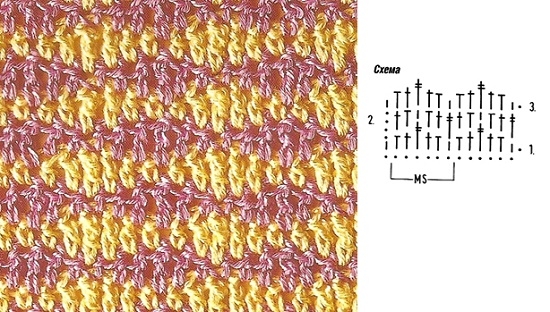
Another jacquard motif emanates from the dense “Crossed Columns” pattern. It got its name thanks to unusual looking. It seems that the columns are twisted together and the threads are intertwined, forming a mesh. This pattern is often used when knitting complex women's swimsuits and bikinis, children's pants, scarves and hats. Mastering the beautiful “Crossed Columns” pattern will be quite simple even for a novice craftswoman.
The statement that learning to crochet is easier than knitting is very controversial. However, there is no doubt that the hook opens up many more possibilities. For many knitters, mastering the skill of crocheting makes it much easier to get more of the project done.
Dense patterns
Despite the fact that crochet is primarily associated with airy openwork, there are situations when you cannot do without a solid fabric. In such cases, it turns out that finding with diagrams is not so easy.
If necessary, perform opaque knitted elements You can use knitting needles, but this option is not always suitable. The fabric made with knitting needles is thinner and more elastic. In addition, tightly knitting a thin thread with this tool is very inconvenient and takes a long time.
Why are dense ornaments needed?
Based on practice, we can indicate the areas of application of solid patterns intended for crocheting:
- Making warm clothing. Winter hats, mittens, sweaters, dresses - all this should be knitted without unnecessary holes or laces.
- Scarves. This clothing is listed as a separate item, since scarves require double-sided dense crochet patterns (patterns are offered below).
- Interior items. Blankets, blankets, rugs, and some models of pillows require a solid fabric through which the lining cannot be seen.
- Swimwear and opaque items
- In order to “dilute” openwork pattern. Sometimes a combination of several rows of openwork mixed with a dense pattern allows you to create a new unique pattern.
Specifics of choosing yarn for solid patterns
Most yarns are suitable for crocheting tight patterns. Patterns are often designed for yarn with a thickness of about 350-400 m/100 grams. This should be taken into account if the thread chosen for knitting differs significantly in thickness from this figure.
Too much will cause the canvas to become rough, overly dense and stiff. In addition, when knitting such products, a large load is created on the fingers and they can hurt. To avoid unpleasant consequences and still use a thick thread, you can use a hook big size(7 or more) and try to knit freely.
A thread with parameters greater than 400 m/100 grams is considered thin. For example, the thickness of mercerized cotton is 560 m/100 grams. Knitting continuous patterns with such a thread requires the use of a very thin hook (from 0.9 mm) and tight knitting. Otherwise, the knitted fabric will turn out to be openwork and will not fulfill its function.
Crochet: dense patterns. Schemes from the must have category
Elementary solid patterns are formed by combining different columns. This can be a traditional stitch, including single crochets (SC) or double crochets (DC). A feature of such patterns is the absence of air loops (AP). An example is the ornament in the photo below. 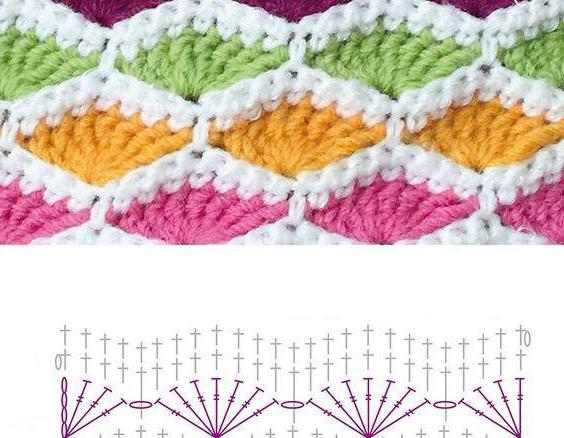 It consists of “bushes” and rows of RLS separating them. The given sample is made in color, but more often it is used in a single color design. It can be called a lifesaver for many knitters.
It consists of “bushes” and rows of RLS separating them. The given sample is made in color, but more often it is used in a single color design. It can be called a lifesaver for many knitters.
And in this modified pattern there is already a VP and an openwork element. 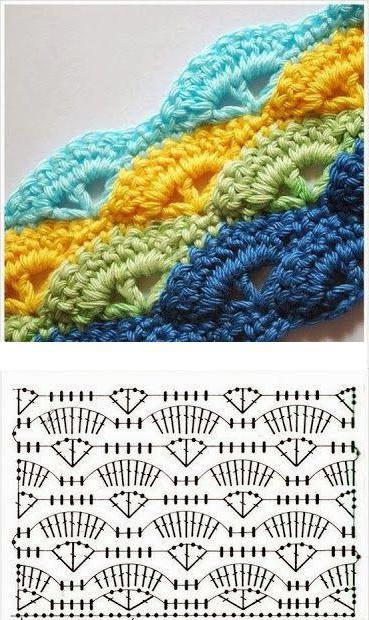 This scheme can easily be adapted to produce a dense fabric. It is enough to replace the VP with a CCH, then the “leg” for the bush will contain not three CCHs and five VPs, but eight CCHs.
This scheme can easily be adapted to produce a dense fabric. It is enough to replace the VP with a CCH, then the “leg” for the bush will contain not three CCHs and five VPs, but eight CCHs.
Dense crochet patterns, the patterns of which are presented below, are also based on the SSN. This technique allows you to create a really dense canvas. The essence of the method is that not the upper part of the column of the previous row, but its main part is used as the basis for volumetric CCHs. The hook is wound behind the dc and the thread is pulled behind it.
This is how convex DCs are knitted.
Zigzag dense crochet patterns: description and diagram
Wavy patterns are very convenient for making continuous fabrics. Such ornaments are formed according to the same principle: adding loops at the peak of the wave and reducing the same number of loops in the trough. Zigzags have their own specifics and features:
- Zigzag dense patterns are difficult to cut; they create difficulties when knitting according to the pattern (sleeve caps, necklines, waist relief). Waves are best suited for knitting even fabrics.
- To correctly calculate the loops, you need to knit a fairly large sample, since the full wavy pattern is formed after knitting about 5 cm of fabric.
- It is necessary to strictly observe the number of added and reduced loops in each row. Ignoring such calculations leads to a gradual change in the proportions of the wave.
Wavy dense crochet patterns, diagrams and a sample are given below, may have minor holes in the fabric (as in the diagram). ![]() If desired, you can achieve a continuous fabric by replacing the Dc in the pattern with a RLS.
If desired, you can achieve a continuous fabric by replacing the Dc in the pattern with a RLS.
Dense openwork patterns
There are crochet patterns that can be called intermediate between openwork and solid. 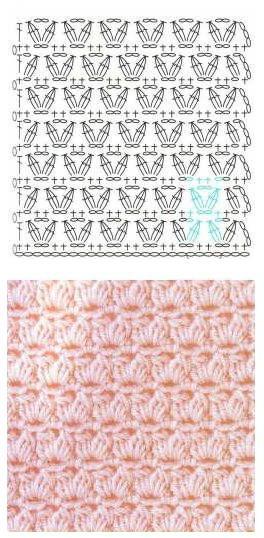 These are quite common crochet patterns, the dense openwork of which is formed due to a small number of air loops in the pattern.
These are quite common crochet patterns, the dense openwork of which is formed due to a small number of air loops in the pattern. 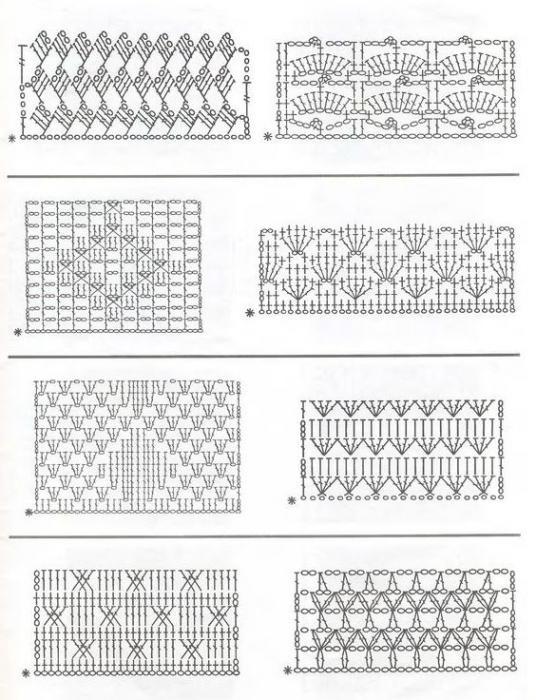
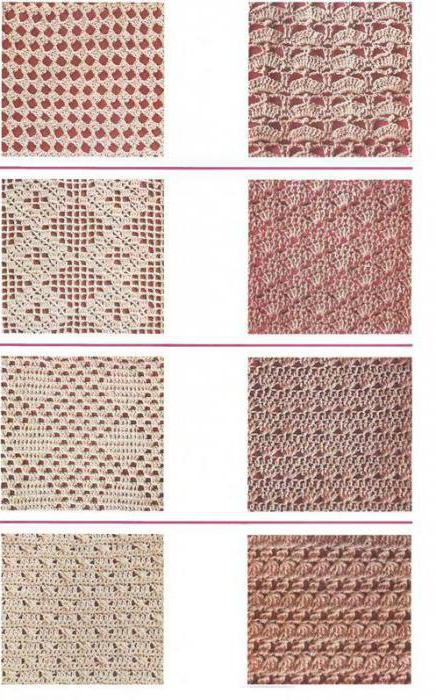
Most crochet patterns that are considered solid fall into this category. Unfortunately, they are not suitable for a swimsuit or skirt, but they will be indispensable for other products. Canvases made with the use of angora and such dense openwork turn out especially well. The lightness of the pattern does not weigh down the model, and the fibers of angora yarn provide warmth.

